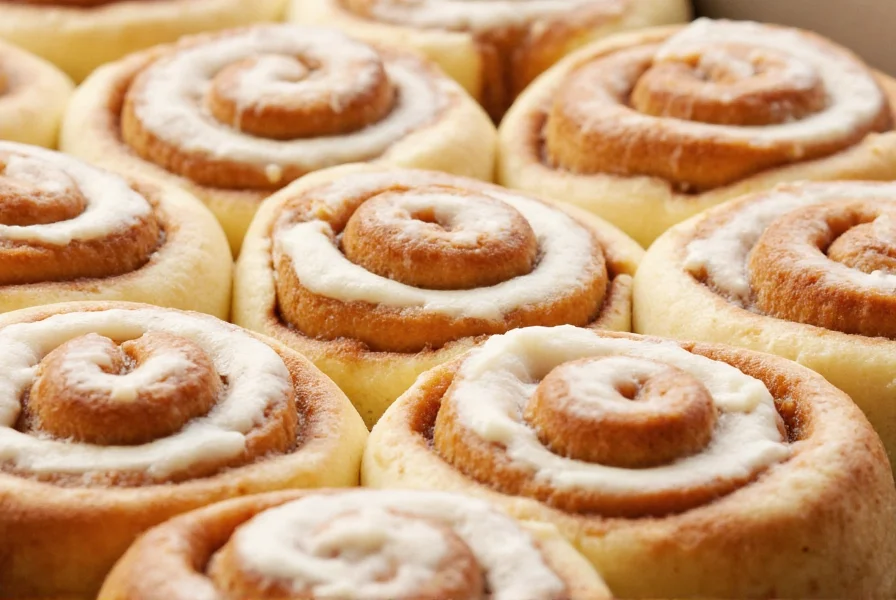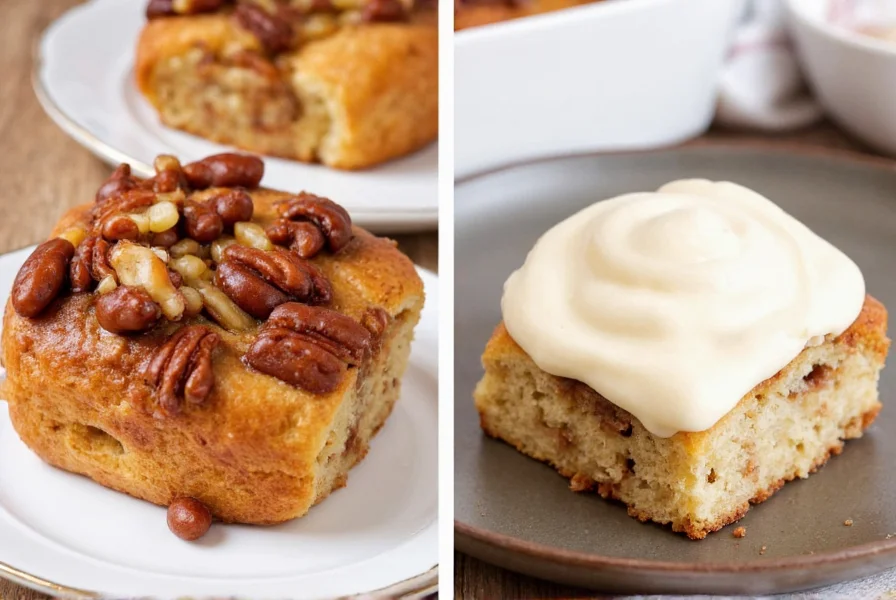Many home bakers and pastry enthusiasts confuse sticky buns with cinnamon rolls, assuming they're identical treats with different names. While both belong to the sweet roll family and share similar dough and spice profiles, they represent distinct preparations with unique characteristics that set them apart.
Defining Cinnamon Rolls
Cinnamon rolls, known as kanelsnurror in Sweden or zimtschnecken in Germany, consist of a yeast-raised dough swirled with a cinnamon-sugar mixture. After baking, they're traditionally topped with a cream cheese or vanilla icing. The dough remains soft and pillowy, with the cinnamon filling creating a marbled pattern throughout.
What makes a classic cinnamon roll distinctive is its preparation method: the dough is rolled into a log, sliced into individual portions, and baked right-side up. When properly made, cinnamon rolls showcase visible spiral patterns when cut open, with the cinnamon sugar distributed evenly through each layer.

Understanding Sticky Buns
Sticky buns, sometimes called sugar buns or schnecken in some regions, feature a distinctive preparation technique. Bakers line the baking pan with a mixture of brown sugar, butter, corn syrup or honey, and often pecans or walnuts. The rolled and sliced dough portions are then placed directly on top of this sticky mixture.
During baking, the sugar mixture melts and caramelizes. After baking, the pan is inverted so the caramelized topping becomes the bottom (now top) of the buns, creating that signature sticky, gooey texture that gives the pastry its name. This upside-down preparation method fundamentally differentiates sticky buns from cinnamon rolls.
Key Differences Comparison
| Characteristic | Sticky Buns | Cinnamon Rolls |
|---|---|---|
| Preparation Method | Baked upside down with caramel base | Baked right-side up |
| Signature Feature | Caramelized nut topping | Cream cheese or vanilla frosting |
| Texture Profile | Crunchy caramel exterior, soft interior | Consistently soft throughout |
| Regional Names | Sugar buns, schnecken (in some areas) | Kanelbulle, zimtschnecke |
| Common Additions | Pecans, walnuts, raisins | Occasional raisins or nuts in filling |
Historical Origins and Regional Variations
The confusion between sticky buns vs cinnamon rolls stems partly from regional naming differences. In some parts of the United States, particularly in Pennsylvania Dutch country, the term "sticky bun" might be used interchangeably with "cinnamon roll," though traditional recipes maintain the distinction.
Cinnamon rolls trace their origins to Swedish and German baking traditions, where they've been popular since the 19th century. Sticky buns, meanwhile, have roots in American baking, with their caramelized preparation method developing as a distinct variation.
When examining authentic regional recipes for sticky buns vs cinnamon rolls, the preparation method remains the most reliable differentiator. True sticky buns always feature that signature inverted baking process with a caramel base, while cinnamon rolls maintain their traditional right-side-up presentation.
Practical Identification Guide
When faced with these pastries, here's how to tell sticky buns from cinnamon rolls:
- Check the bottom - If it has a caramelized, sticky layer with visible nuts, it's a sticky bun
- Examine the topping - Cream cheese frosting indicates a cinnamon roll
- Consider the texture - Sticky buns have a distinct crunchy-sweet exterior from the caramel
- Look at the presentation - Sticky buns often come slightly flattened from the inversion process

Common Misconceptions Clarified
One persistent myth suggests that sticky buns vs cinnamon rolls differ only in name based on geography. While regional variations exist, the preparation method creates fundamentally different eating experiences. Another misconception claims that the presence of nuts defines sticky buns, but it's actually the caramelized preparation method that matters most.
Understanding the difference between sticky buns and cinnamon rolls helps bakers select the appropriate recipe for their desired outcome. Those seeking a gooey, caramel-forward treat should opt for sticky buns, while those preferring a consistently soft pastry with frosting should choose cinnamon rolls.
Conclusion
While sticky buns and cinnamon rolls share common ingredients and belong to the same pastry family, they represent distinct preparations with unique characteristics. The key difference between sticky buns vs cinnamon rolls lies in the baking method and resulting texture profile. Sticky buns feature that signature caramelized bottom layer that becomes the top, while cinnamon rolls maintain their traditional right-side-up presentation with frosting. Recognizing these differences enhances both baking precision and culinary appreciation of these beloved sweet treats.
Frequently Asked Questions
Are sticky buns just cinnamon rolls with caramel?
No, sticky buns aren't simply cinnamon rolls with caramel. While both contain cinnamon and sugar, sticky buns are baked upside down in a caramel-nut mixture that becomes the topping when inverted. Cinnamon rolls are baked right-side up and typically topped with cream cheese frosting after baking.
Why are they called sticky buns if cinnamon rolls are also sticky?
The name "sticky bun" specifically refers to the caramelized sugar mixture that creates a distinct sticky texture. While cinnamon rolls can be moist, they don't feature the same level of caramelized stickiness that defines authentic sticky buns, which get their name from the signature gooey topping that often requires eating with a fork.
Can I make sticky buns using a cinnamon roll recipe?
You can adapt a cinnamon roll recipe to make sticky buns by lining your baking pan with a caramel mixture of brown sugar, butter, and corn syrup before placing the rolled dough on top. The key difference in preparation is baking them upside down so the caramel becomes the topping when inverted after baking.
Which is older historically, sticky buns or cinnamon rolls?
Cinnamon rolls have older origins, tracing back to Swedish and German baking traditions from the 19th century. Sticky buns developed later as an American variation, with their distinctive caramel preparation method emerging in the early 20th century, particularly in Pennsylvania Dutch baking traditions.
Do sticky buns always contain nuts?
While traditional sticky buns often include pecans or walnuts in the caramel base, authentic recipes don't strictly require nuts. The defining characteristic is the caramelized sugar mixture that creates the sticky texture. Some regional variations omit nuts entirely while maintaining the essential preparation method that distinguishes sticky buns from cinnamon rolls.











 浙公网安备
33010002000092号
浙公网安备
33010002000092号 浙B2-20120091-4
浙B2-20120091-4